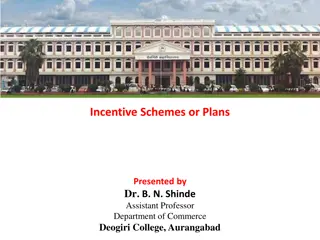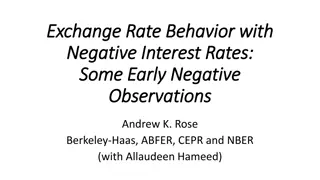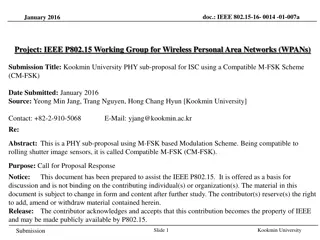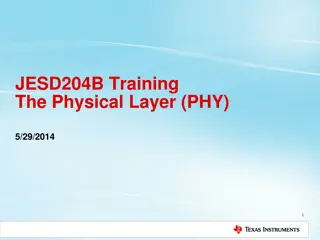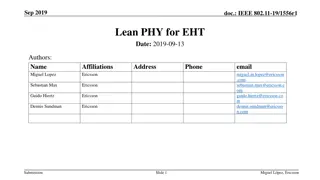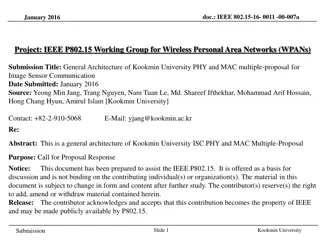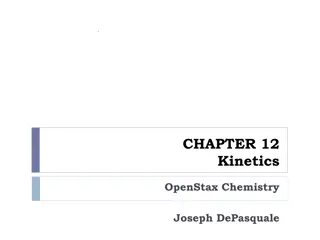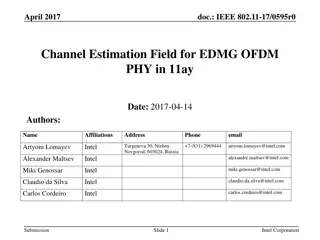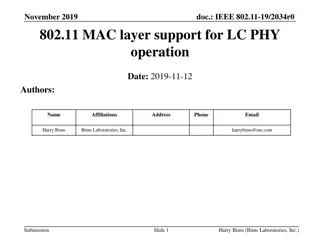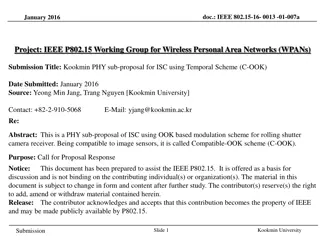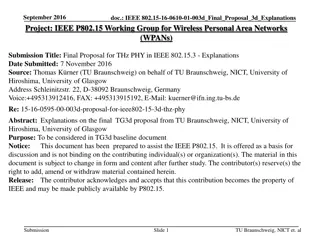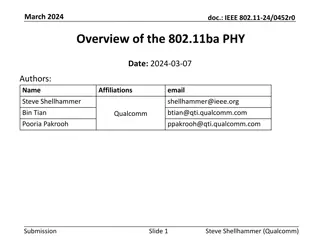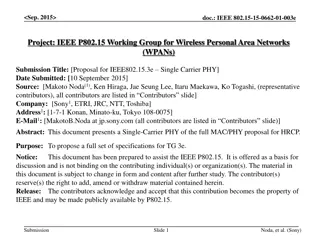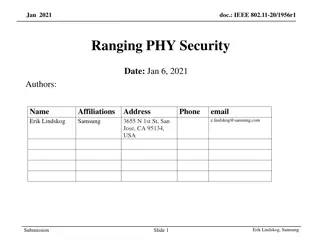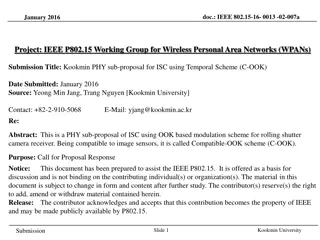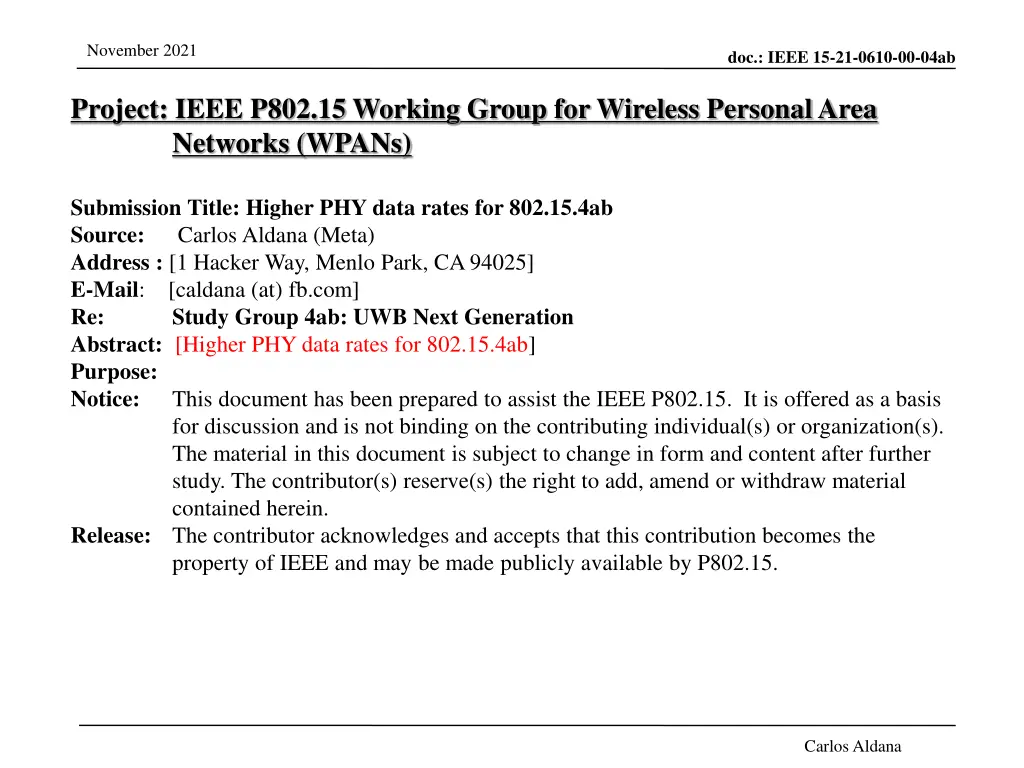
Enhancing PHY Data Rates for Wireless Personal Area Networks
Explore the proposal for higher PHY data rates in IEEE 802.15.4ab standard to support advanced use cases without disrupting existing applications. Key elements include interference mitigation, coexistence improvements, enhanced ranging capabilities, and support for various communication protocols.
Download Presentation

Please find below an Image/Link to download the presentation.
The content on the website is provided AS IS for your information and personal use only. It may not be sold, licensed, or shared on other websites without obtaining consent from the author. If you encounter any issues during the download, it is possible that the publisher has removed the file from their server.
You are allowed to download the files provided on this website for personal or commercial use, subject to the condition that they are used lawfully. All files are the property of their respective owners.
The content on the website is provided AS IS for your information and personal use only. It may not be sold, licensed, or shared on other websites without obtaining consent from the author.
E N D
Presentation Transcript
November 2021 doc.: IEEE 15-21-0610-00-04ab Project: IEEE P802.15 Working Group for Wireless Personal Area Networks (WPANs) Submission Title: Higher PHY data rates for 802.15.4ab Source: Carlos Aldana (Meta) Address : [1 Hacker Way, Menlo Park, CA 94025] E-Mail: [caldana (at) fb.com] Re: Study Group 4ab: UWB Next Generation Abstract: [Higher PHY data rates for 802.15.4ab] Purpose: Notice: This document has been prepared to assist the IEEE P802.15. It is offered as a basis for discussion and is not binding on the contributing individual(s) or organization(s). The material in this document is subject to change in form and content after further study. The contributor(s) reserve(s) the right to add, amend or withdraw material contained herein. Release: The contributor acknowledges and accepts that this contribution becomes the property of IEEE and may be made publicly available by P802.15. Carlos Aldana
November 2021 doc.: IEEE 15-21-0610-00-04ab Technical Guidance [1] PAR Objective Safeguards so that the high throughput data use cases will not cause significant disruption to low duty-cycle ranging use cases. Proposed Solution (how addressed) Interference mitigation techniques to support higher density and higher traffic use cases Other coexistence improvement Backward compatibility with enhanced ranging capable devices (ERDEVs). Improved link budget and/or reduced air-time Higher PHY rates reduce air-time Additional channels and operating frequencies Improvements to accuracy / precision / reliability and interoperability for high-integrity ranging; Reduce complexity and power consumption; Hybrid operation with narrowband signaling to assist UWB; Enhanced native discovery and connection setup mechanisms; Sensing capabilities to support presence detection and environment mapping; Low-power low-latency streaming higher data-rate streaming allowing at least 50 Mbit/s of throughput. Support for peer-to-peer, peer-to-multi-peer, and station-to-infrastructure protocols; Higher PHY rates will help enable this use case Infrastructure synchronization mechanisms. Carlos Aldana Slide 2
November 2021 doc.: IEEE 15-21-0610-00-04ab Related Submissions 15-21-592 High Data Rates , Carl Murray et.al (Qorvo) 15-21-501 Ways to achieve higher data rate for the HRP UWB PHY , Chenchen Liu (Huawei) Carlos Aldana Slide 3
November 2021 doc.: IEEE 15-21-0610-00-04ab HPRF Data Communications Review HPRF mode was introduced PRF of 249.6 MHz providing 27.2 (RS)/31.2(no RS) Mbps For PRF of 249.6 MHz, the following structure is used (8 pulses per bit), with symbol duration = 32.05 ns PRF: Pulse Repetition Frequency RS: Reed Solomon Slide 4 Carlos Aldana
November 2021 Proposed Modulation, pulse grid Keep BPSK, PRF, rate = , and Tchip 62.4 Mbps data rate g0 g1 doc.: IEEE 15-21-0610-00-04ab Guard Interval Tdsym=16.03 ns 124.8 Mbps data rate g0 g1 Guard Interval Tdsym=8.01 ns Carlos Aldana Slide 5
November 2021 doc.: IEEE 15-21-0610-00-04ab Equalizer Block Diagram ? ? received signal Demodulator/Deco der ADC FFE w The equalizer output is given by ? = ? ? Equalizer length L = 50 ? : equalizer taps, a column vector of size 50 1 ? : Toeplitz channel matrix of size 50 (channel_length + 49) ? : identity matrix of size 50 50 g : column vector of size (channel_length + 49) 1 The FFE equalizer taps that are optimal in the MMSE sense are given by 1?g 1 1??? = ?? + ? = ??? ???? ?is the Toeplitz matrix of the channel response, and g = [0, , 0, 1, 0, , 0]T indicates the desired output element. We assume Rxx is identity. ??: equalizer taps at time ? ??= ?? ?? ? : update step-size ?? : scalar estimation error In practice, we can use the LMS algorithm to train the equalizer taps ??) ?? ??=??+ ? (?? ?? ??+1 = ??+ ??? Note that when using LMS, channel knowledge is not needed Carlos Aldana
November 2021 doc.: IEEE 15-21-0610-00-04ab Simulation Assumptions 127 byte data payload Root raised cosine pulse shape with roll-off factor = 0.45 SYNC Preamble Code 9 (length 127) 32 Sync symbols to estimate channel No frequency offset and perfect timing Assume (for now) RS is present with CL3 (Constraint Length 3). CL7 does not have RS. Without RS, CL7 achieves higher rate (e.g., 31.2 vs 27.2) No fixed bit-width ADC Carlos Aldana Slide 7
November 2021 doc.: IEEE 15-21-0610-00-04ab PER in AWGN Required SNR for 10% PER 6.8 Mbps (BPRF) 6.8 Mbps (HPRF) 7.8 Mbps (HPRF) 27.2 Mbps (HPRF) 31.2 Mbps (HPRF) 54.5 Mbps (proposed) 62.4 Mbps (proposed) 109.0 Mbps (proposed) 124.8 Mbps (proposed) -14.9dB -14.9dB -14.5dB -9.2dB -8.8dB -6.2dB -5.7dB -3.2dB -2.8dB Carlos Aldana Slide 8
November 2021 doc.: IEEE 15-21-0610-00-04ab PER in CM1 ( Exact equalizer) Required SNR for 10% PER 6.8 Mbps (BPRF) 6.8 Mbps (HPRF) 7.8 Mbps (HPRF) 27.2 Mbps (HPRF) 31.2 Mbps (HPRF) 54.5 Mbps (proposed) 62.4 Mbps (proposed) 109.0 Mbps (proposed) 124.8 Mbps (proposed) -14.6dB -14.7dB -14.3dB -8.7dB -8.2dB -5.2dB -4.7dB -1.5dB -1.0dB CM1 results within 1.8 dB from AWGN Carlos Aldana Slide 9
November 2021 PER in CM1 (Equalizer w/ LMS) doc.: IEEE 15-21-0610-00-04ab Required SNR for 10% PER 6.8 Mbps (BPRF) 6.8 Mbps (HPRF) 7.8 Mbps (HPRF) 27.2 Mbps (HPRF) 31.2 Mbps (HPRF) 54.5 Mbps (proposed) 62.4 Mbps (proposed) 109.0 Mbps (proposed) 124.8 Mbps (proposed) -14.3dB -14.4dB -14.1dB -8.6dB -8.2dB -5.3dB -4.6dB -1.5dB -1.1dB LMS results within 0.3 dB from exact equalizer Trained Carlos Aldana Slide 10
November 2021 doc.: IEEE 15-21-0610-00-04ab Conclusions With simple equalizer design,124.8 Mbps PHY rate seems achievable with reasonable complexity CM1 results are within 1.8 dB from AWGN LMS equalizer close to exact equalizer Higher data rates allow for higher throughput, lower duty cycle and reduced air-time. Carlos Aldana Slide 11



